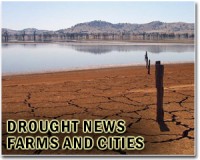| . |  |
. |
Washington DC (SPX) Feb 07, 2011 A new, detailed record of rainfall fluctuations in ancient Mexico that spans more than twelve centuries promises to improve our understanding of the role drought played in the rise and fall of pre-Hispanic civilizations. Prior evidence has indicated that droughts could have been key factors in the fates of major cultures in ancient Mexico and Central America (Mesoamerica). But there have been many gaps in the paleoclimate record, such as the exact timing and geographic extension of some seemingly influential dry spells. The new, 1,238-year-long tree-ring chronology, the longest and most accurate of its kind for Mesoamerica, is the first to reconstruct the climate of pre-colonial Mexico on an annual basis for more than a millennium, pinning down four ancient megadroughts to their exact years. One large ancient drought previously confirmed for the Southwest of the United States is shown to have extended into central Mexico (1149-1167 AD) by the new dendrochronology, or tree-ring reconstruction. There it may have devastated the local maize crops, potentially giving a fatal blow to the declining Toltec culture, says David Stahle, a paleoclimatologist at the University of Arkansas at Fayetteville and lead author of the new study. Stahle and his colleagues present their new findings in a paper that has been accepted for publication in Geophysical Research Letters, a journal of the American Geophysical Union. The new record also pins down more precisely than ever before the time periods of two other extended and severe dry periods, possibly leading to new insights into the Aztecs's rise to power, and into the spread of exotic diseases that Spanish Conquistadores brought to America. This far-reaching rainfall chronology also provides the first independent confirmation of the so-called Terminal Classic drought, a megadrought some anthropologists relate to the collapse of the Mayan civilization. This decades-long dry period had been previously determined by analysis of lake and basin sediments in other areas of Mexico and the Caribbean. But Stahle's team has narrowed the event's timing to 897-922 AD and confirmed that it had a wider geographical impact than previously thought, extending into the highlands of Central Mexico, where other classic period cultures were located. "Certainly these cultural changes were very complicated - probably not one single explanation can account for the collapse of the Mayan civilization," Stahle says. "[But] our study will allow other scientists to more thoroughly investigate and understand the impact of these droughts." Stahle and his team used data from 74 core samples extracted from 30 specimens of millennium-old Montezuma baldcypress trees (Taxodium mucronatum) growing in the canyon of Amealco, Queretaro - only 90 kilometers (56 miles) away from Tenochtitlan, capital of the Aztec empire, and 60 km (37 miles) northeast from Tula, the Toltec state's main city. Stahle says this tree species, related to North American sequoias, is the only plant in Central America that frequently lives up to one thousand years or more. "This is the national tree of Mexico, and it tells such an interesting story of the decline of the Mexican empires", says Stahle, adding that previous tree chronologies for Mexico were only three to four centuries long. "This is the first one that goes back into pre-Hispanic times," The researchers determined the year of formation for each tree ring and analyzed what the rings' growth patterns had to say about how soil moisture varied from growth season to growth season over the years, a parameter directly associated with rainfall. "The beauty of tree rings is that they're annual: you get an estimate for wetness for every single year - you don't get it from other archives, not as precisely," Stahle says. "This research... highlights the role fine-grained climate data can play in helping us understand the trajectories of past human societies," says David Anderson, an archaeologist at the University of Tennessee, Knoxville who was not involved in the new study. "This study will prompt a great deal of follow-up research by archaeologists and paleoclimatologists alike, and offers lessons for our own civilization - specifically how vulnerable complex societies may be to drought-induced crop failures." This research received funding from the National Science Foundation's Paleoclimatology Program and the Inter-American Institute for Global Change Research.
Share This Article With Planet Earth
Related Links University of Arkansas Climate Science News - Modeling, Mitigation Adaptation
 China farmers to get $15 bn subsidies amid drought
China farmers to get $15 bn subsidies amid droughtBeijing (AFP) Jan 21, 2011 China says it had earmarked about $15 billion in subsidies for millions of farmers who have been hit by a severe drought that has driven prices as the government tries to battle inflation. The dry spell in the north and south has affected about four million hectares (9.9 million acres), official figures show, and has been blamed for destroying crops. Farmers will receive 98.6 billion yua ... read more |
|
| The content herein, unless otherwise known to be public domain, are Copyright 1995-2010 - SpaceDaily. AFP and UPI Wire Stories are copyright Agence France-Presse and United Press International. ESA Portal Reports are copyright European Space Agency. All NASA sourced material is public domain. Additional copyrights may apply in whole or part to other bona fide parties. Advertising does not imply endorsement,agreement or approval of any opinions, statements or information provided by SpaceDaily on any Web page published or hosted by SpaceDaily. Privacy Statement |